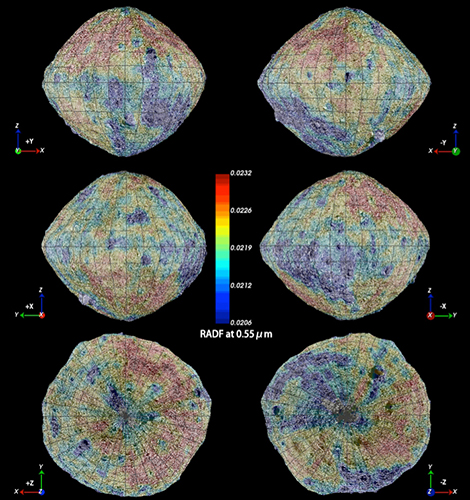The Global Average Disk-Resolved Photometric Properties of (101955) Bennu
- 1Planetary Science Institute, Tucson, USA (zouxd@psi.edu)
- 2Department of Physics and Astronomy, Ithaca College, Ithaca, USA
- 3Lunar and Planetary Laboratory, University of Arizona, Tucson, USA
- 4NASA Goddard Space Flight Center, Greenbelt, USA
- 5LESIA, Observatoire de Paris, Université PSL, CNRS, Université de Paris, Sorbonne Université, 921 Meudon, France
- 6Institut Universitaire de France (IUF), Paris, France
- 7Department of Geography, University of Winnipeg, Winnipeg, Manitoba, Canada
- 8Instituto de Astrofísica de Canarias, University of La Laguna, La Laguna, Tenerife, Spain
- 9Department of Earth and Planetary Science, The University of Tokyo, Bunkyo, Tokyo, Japan
1.Introduction
NASA’s OSIRIS-REx (Origins, Spectral Interpretations, Resource Identification, and Security–Regolith Explorer) asteroid sample return mission (Lauretta et al., 2017) began operating in proximity to near-Earth asteroid (101955) Bennu in December 2018. Here we present an analysis of the global photometry of Bennu from measurements by the OSIRIS-REx Visible and InfraRed Spectrometer (OVIRS; Reuter et al., 2018). This instrument is a point spectrometer with a wedged filter design. OVIRS is used for the spectral characterization of the surface of Bennu, with a field of view of 4 mrad and an effective spectral range from 0.4 to 4.3 μm. Our work focuses on OVIRS data acquired from December 9, 2018, to September 26, 2019.
2.Dataset
This study comprises the global observation data from Preliminary Survey and the two sub-phases of Detailed Survey, Baseball Diamond (BBD) and Equatorial Stations (EQ) (campaigns described in Lauretta et al., 2017). We use a total of 299,702 calibrated spots. More details about the data selection and calibration are introduced by Zou et al. (submitted).
3.Photometric analyses
We model the scattering properties of the surface of Bennu using the Lommel-Seeliger, Minnaert, McEwen, and Akimov photometric models. The best-fit model is a McEwen model with an exponential phase function and an exponential polynomial partition function. We use this model to correct the OVIRS spectra of Bennu to a standard reference viewing and illumination geometry at visible to infrared wavelengths for the purposes of global spectral mapping (Figure 1). We derive a bolometric Bond albedo map in which Bennu’s surface values range from 0.021 to 0.027. We find a phase reddening effect of 1.4±0.3 × 10−4 μm−1deg−1 across the wavelength range 0.48 to 2.5 μm, and our model is effective at removing this phase reddening.
We compare our OVIRS results to Golish et al. (2020)’s report on the global photometry of Bennu, based on imaging data from the OSIRIS-REx Camera Suite (OCAMS; Rizk et al., 2018). We also compare the results to ground observation and other minor planets including Ryugu.
Acknowledgements: This material is based upon work supported by NASA under Contract NNM10AA11C issued through the New Frontiers Program. We are grateful to the entire OSIRIS-REx Team for making the encounter with Bennu possible and the exploration highly successful. X.-D. Zou and J.-Y. Li also acknowledge partial support from the Solar System Exploration Research Virtual Institute 2016 (SSERVI16) Cooperative Agreement (Grant NNH16ZDA001N), SSERVI-TREX to the Planetary Science Institute. M. A. Barucci acknowledges funding support from CNES.
References
Bennett, C.A., et al. 2020. A high-resolution global basemap of (101955) Bennu. Icarus. doi: 10.1016/j.icarus.2020.113690.
Ernst et al., 2018, The Small Body Mapping Tool (SBMT) for Accessing, Visualizing, and Analyzing Spacecraft Data in Three Dimensions, LPSC 49, abstract no. 1043.
Golish, D.R., et al. 2020. Disk-resolved photometric modeling and properties of asteroid (101955) Bennu. Icarus, doi:10.1016/j.icarus.2020.113724.
Lauretta, D.S., et al. 2017. OSIRIS-REx: sample return from asteroid (101955) Bennu. Space Science Reviews 212(1-2):925-984.
Reuter, D.C., et al. 2018. The OSIRIS-REx Visible and InfraRed Spectrometer (OVIRS): spectral maps of the asteroid Bennu. Space Science Reviews 214(2):54.
Rizk, B., et al. 2018. OCAMS: the OSIRIS-REx Camera Suite. Space Science Reviews 214(1):26.
Zou et al. (submitted). Photometry of asteroid (101955) Bennu with OVIRS on OSIRIS-REx. Icarus.

Figure 1. A global 3D facet-based map of the photometrically corrected (to 30°, 0°, 30°) OVIRS spots at a wavelength of 0.55 μm. The data are overlain on the OCAMS imaging basemap (Bennett et al., 2020), as viewed in the Small Body Mapping Tool (Ernst et al. 2018). Input spectra were obtained during Detailed Survey EQ3.
How to cite: Zou, X.-D., Li, J.-Y., Clark, B., Golish, D., Ferrone, S., Simon, A., Reuter, D., Domingue, D., Kaplan, H., Barucci, M., Fornasier, S., Praet, A., Hasselmann, P., Bennett, C., Cloutis, E., Tatsumi, E., DelllaGiustina, D., and Lauretta, D.: The Global Average Disk-Resolved Photometric Properties of (101955) Bennu, Europlanet Science Congress 2020, online, 21 Sep–9 Oct 2020, EPSC2020-146, https://doi.org/10.5194/epsc2020-146, 2020.

